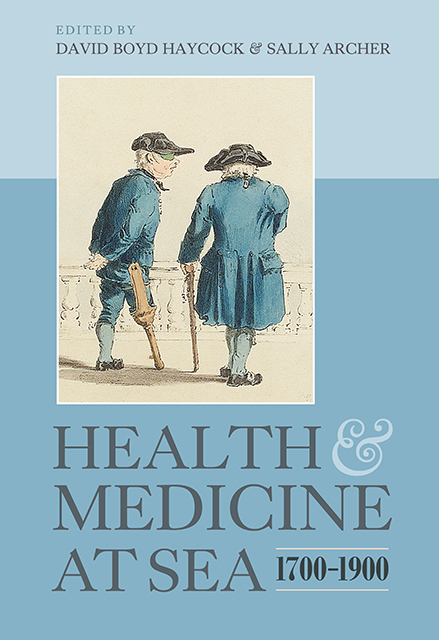Book contents
- Frontmatter
- Contents
- List of Figures and Tables
- Preface
- List of Contributors
- Acknowledgements
- List of Abbreviations
- Introduction Health, Medicine and the Maritime World: A History of Two Centuries
- 1 ‘The Intention is Certain Noble’: The Western Squadron, Medical Trials, and the Sick and Hurt Board during the Seven Years War (1756–63)
- 2 Royal Navy Surgeons, 1793–1815: A Collective Biography
- 3 Surgery in the Royal Navy during the Republican and Napoleonic Wars (1793–1815)
- 4 The Sick and Hurt Board: Fit for Purpose?
- 5 An ‘Important and Truly National Subject’: The West Africa Service and the Health of the Royal Navy in the Mid Nineteenth Century
- 6 Mortality and Migration: A Survey 128
- 7 Slave Purchasing Strategies and Shipboard Mortality: Day-to-Day Evidence from the Dutch African Trade, 1751–1797
- 8 Ships, Families and Surgeons: Migrant Voyages to Australia in the Age of Sail
- 9 Medical Encounters on the Kala Pani: Regulation and Resistance in the Passages of Indentured Indian Migrants, 1834–1900
- Bibliography
- Index
7 - Slave Purchasing Strategies and Shipboard Mortality: Day-to-Day Evidence from the Dutch African Trade, 1751–1797
Published online by Cambridge University Press: 07 March 2023
- Frontmatter
- Contents
- List of Figures and Tables
- Preface
- List of Contributors
- Acknowledgements
- List of Abbreviations
- Introduction Health, Medicine and the Maritime World: A History of Two Centuries
- 1 ‘The Intention is Certain Noble’: The Western Squadron, Medical Trials, and the Sick and Hurt Board during the Seven Years War (1756–63)
- 2 Royal Navy Surgeons, 1793–1815: A Collective Biography
- 3 Surgery in the Royal Navy during the Republican and Napoleonic Wars (1793–1815)
- 4 The Sick and Hurt Board: Fit for Purpose?
- 5 An ‘Important and Truly National Subject’: The West Africa Service and the Health of the Royal Navy in the Mid Nineteenth Century
- 6 Mortality and Migration: A Survey 128
- 7 Slave Purchasing Strategies and Shipboard Mortality: Day-to-Day Evidence from the Dutch African Trade, 1751–1797
- 8 Ships, Families and Surgeons: Migrant Voyages to Australia in the Age of Sail
- 9 Medical Encounters on the Kala Pani: Regulation and Resistance in the Passages of Indentured Indian Migrants, 1834–1900
- Bibliography
- Index
Summary
Ever since British abolitionists first highlighted the issue in the 1780s, the mortality of enslaved Africans in the Middle Passage from Africa to America has been a preoccupation of scholars studying the Atlantic slave trade. Following Curtin's pioneering work on the epidemiology of the slave trade in the late 1960s, discoveries of new shipping data have allowed major strides to be made in tracking long-run trends in slave mortality. Such data have also been used to evaluate possible causes of shipboard mortality of slaves. Historians now tend to give less credence to the impact of crowding of slaves on board ship, intensive though that was by most historic standards, and prefer instead to place greater weight on the place of embarkation of captives in Africa and on declining levels of shipboard epidemics as factors in shaping mortality trends. In this respect, the trends in mortality are seen as reflective of broader changes in public health and disease prevention in the Atlantic world. Despite the tendency of shipboard mortality of slaves to fall, notably in the eighteenth century, the loss of slaves in transit remained an inevitable part of the slave trade, a fact reflected in the insurance policies for slave voyages. Until now, however, the relationship between slave mortality and purchasing strategies of traders on the African coast has been only vaguely understood. A critical constraint to understanding the relationship is the lack of data relating to patterns of slave purchases in Africa by shipmasters and the actual time spent on board ship by slaves. This essay sheds light on both these issues.
Slave mortality has been pivotal to discussions of the ‘Middle Passage’ from Africa to the Americas. Historians typically define it as starting when ships left the coast. For each slave, however, it actually began as soon as he or she boarded ship. This might be weeks, if not months, before the ship began its voyage to the Americas. Moreover, a considerable number of enslaved Africans died before the Atlantic crossing. Understanding how shippers adapted their purchasing strategies to the risks of slave mortality in transit, and how this affected survival rates, requires redefining the Middle Passage to embrace the whole time spent by slaves on board ship. In other words, we have to shift attention from the merchant's point of view to the slave experience.
- Type
- Chapter
- Information
- Health and Medicine at Sea, 1700-1900 , pp. 143 - 171Publisher: Boydell & BrewerPrint publication year: 2009

